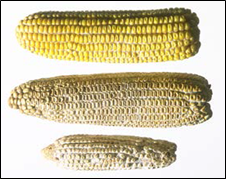Stenocarpella (Diplodia) Ear Rot
Stenocarpella (Diplodia) Ear Rot
Symptoms
The more common ear rots occurring in Kentucky include: Stenocarpella (Diplodia) ear rot and Fusarium ear rot.
Stenocarpella (formerly known as Diplodia) ear rot is characterized by a white mold found growing between the kernels. The mold, which can cover the entire ear and become quite extensive, usually begins at the ear base and

Diplodia ear rot
Paul Vincelli, University of KY
moves up from the shank. Black pycnidia (fungal fruiting bodies) may be scattered on husks, floral bracts and sides of kernels. Husks on ears may become bleached, with the inner husks adhering tightly to one another or to the ear. Infected ears are often lightweight and stand upright on the plant.
Cause
This ear rot is caused by the fungus Stenocarpella maydis. The disease is favored in fields with no-till cultivation that have been continuously planted in corn. The symptoms are generally not observed until late in the season, near harvest maturity.
IPM Techniques
- Observe for ear rot from dough stage through harvest.
- Choose hybrids with some resistance to Stenocarpella ear rot.
- Clean bins before storage.
- Harvest at about 25% moisture and dry to 15% moisture within 24-48 hours for shelled corn to minimize kernel damage and field losses.
- Rotate crops away from corn for at least two years following a severe outbreak.
References and Additional Information
- IPM-2 Kentucky IPM Manual for Corn
- PPA-10a Kentucky Plant Disease Management Guide for Corn and Sorghum, P. Vincelli and D.E. Hershman, Extension Plant Pathology, University of Kentucky
- PPA-43 Ear Rot of Corn Caused by Stenocarpella maydis (=Diplodia maydis), P. Vincelli, Extension Plant Pathology, University of Kentucky
- Compendium of Corn Diseases.M.C. Shurtleff. The Amer. Phytopathol. Soc. 1980.
Corn Diseases and Corn Insects Menu


